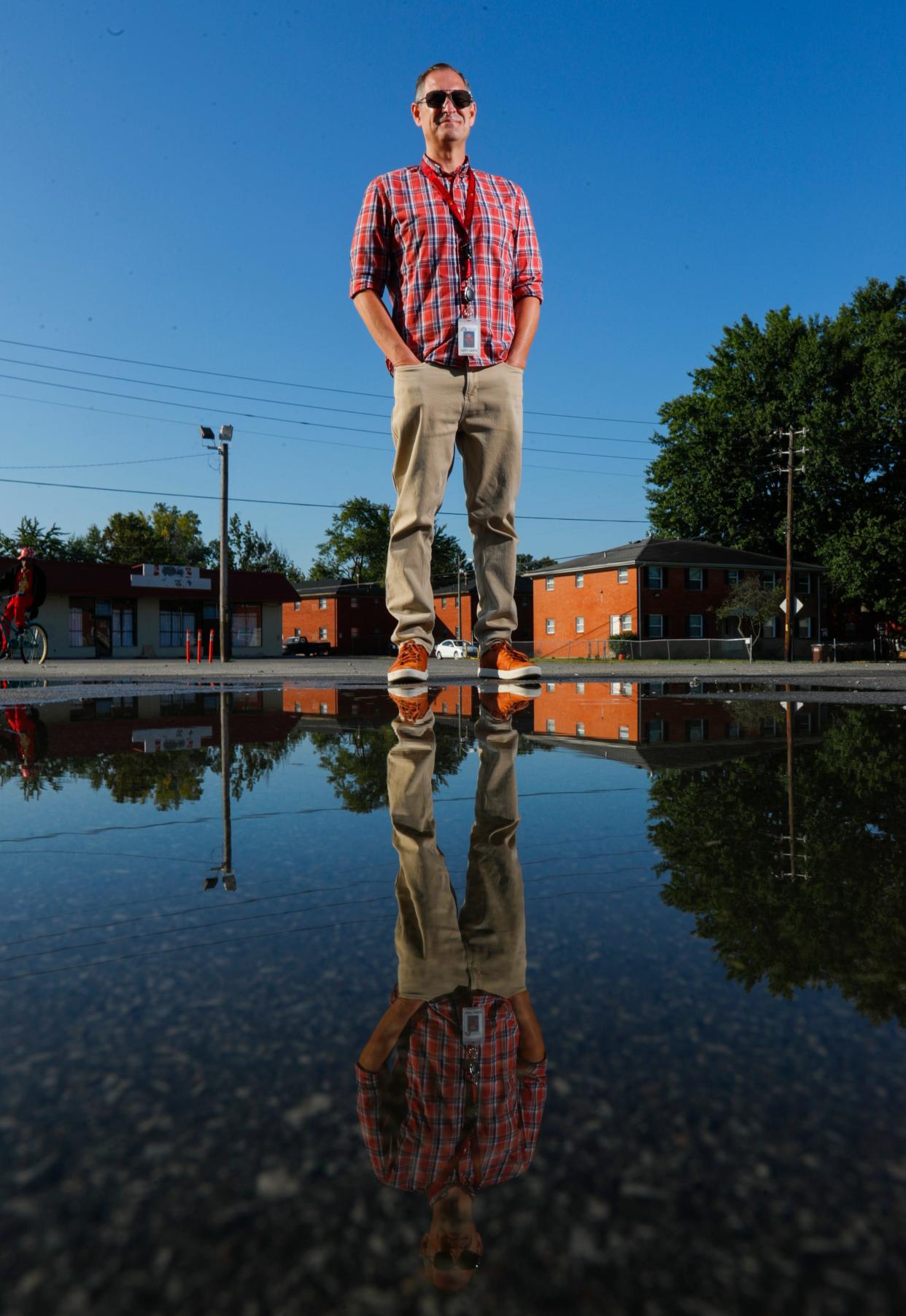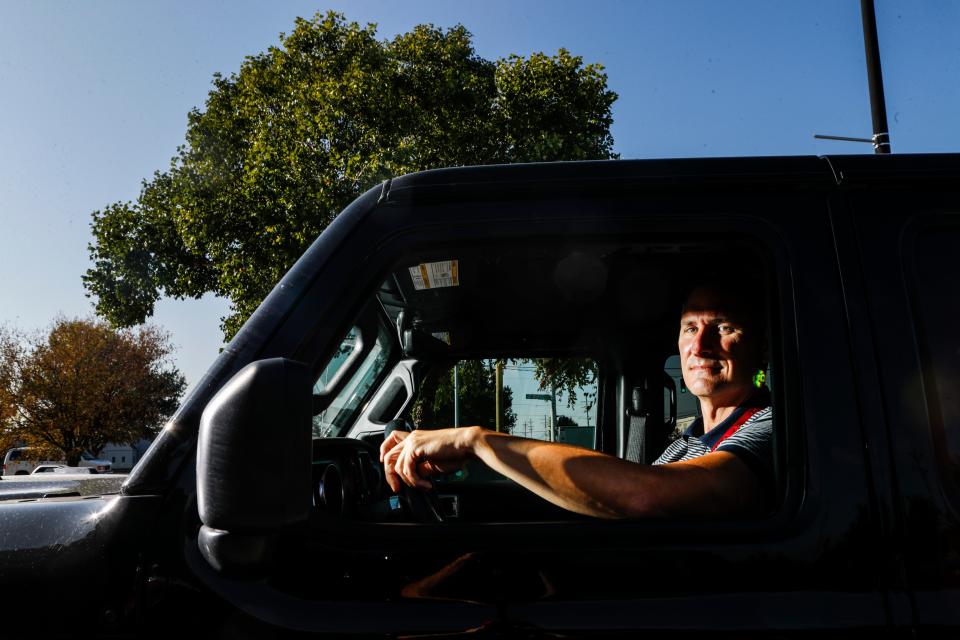Anxiety after the pandemic? Thousands of JCPS students 'chronically absent' from school

Chris Lantz got in his Jeep on a recent Tuesday with a list in hand that would guide him to the homes of students across Jefferson County who haven't been showing up for school.
The reasons for their absence could be myriad, he said.
It could be a job loss. It could be a language barrier if the student is an immigrant. It could be bullying or another mental health issue.
"There's so many different little factors that contribute to this, that contribute to that," said Lantz, who has tracked down absent students for eight years. "They are dealing with so much more, sometimes school is the smallest issue to get to."
Lantz, an assistant director of pupil personnel, is one of 25 people within the district tasked with not just tracking down absent kids but trying to eliminate barriers that keep them out of class. They serve as conduits between the district, its students and organizations that could help struggling families.
The need for their jobs has leaped since the onset of the COVID-19 pandemic in 2020. In the 2022-2023 school year, about 37% of JCPS students were chronically absent, meaning they missed at least 10% of the school year, according to preliminary district data obtained through an open records request. For comparison, 23% of students were chronically absent in the year before the pandemic, and 34% were so in 2021-22.
The trend is troubling because it means about 35,000 students missed out on a significant amount of instructional time, compounding on the academic losses that occurred when schools went virtual. They also missed out on the socialization experiences schools provide.
Further troubling is that in Kentucky, districts are funded based on student attendance — so more absences equates to less dollars.
In a large urban district like JCPS, where about 63% of students and their families live in poverty, chronic absenteeism has always been an issue. Unstable housing arrangements or a lack of transportation can be significant barriers to education for some.
"Not only is it the kid, when you pull the layers back on the onion, there's a lot more going on in their lives," Lantz said about why students are absent so much.
Experts also point to increased anxiety among students across the country related to COVID shutdowns. Closures created deep concerns among educators who feared how far students would fall behind. More than the academic loss, many students also lost out on the socialization aspect of school.
As a country, about 33% of students fell into this category. Before the pandemic, only 15% of U.S. students missed that much school.
Data for the rest of Kentucky's districts won't be released until November, but JCPS' 37% far outpaces the state's average for 2021-2022, when about 28% of students were chronically absent.
An analysis of national chronic absenteeism data by Stanford University education professor Thomas Dee in partnership with the Associated Press found that case rates and masking policies did not directly impact absence rates, suggesting other barriers like mental health and deteriorating school engagement could be at play.
Hedy Chang, executive director of the national nonprofit Attendance Works, said the country's rate of chronically absent students is astronomical compared to pre-pandemic times.
![Hedy Chang, executive director of Attendance Works, talks during a breakout session at the Providence Public School District's student community summit. [The Providence Journal / Bob Breidenbach]](https://s.yimg.com/ny/api/res/1.2/0PGgdG2BYG9bJmdQn2jidw--/YXBwaWQ9aGlnaGxhbmRlcjt3PTk2MDtoPTEyNzY-/https://media.zenfs.com/en/the-courier-journal/91df5fbb323b4fcf125bdaaef89fc84f)
"Absolutely," it's the worst it has ever been, Chang said.
Like Lantz, she pointed to a variety of issues, many of which existed before the March 2020 COVID shutdowns but have been exacerbated in the aftermath. While absences among impoverished and disabled students have historically been higher, Chang said multiple states are seeing more absences among affluent students than ever before.
"Transportation, poor housing, food insecurity, lack of access to health care — those are worse for kids in poverty," she said. "But the anxiety issues, the not being clear on whether I should keep my kid home or not, the sense of lacking meaningful relationships — those can affect kids in poverty and those that are more affluent."
Kids "are feeling incredibly anxious about school," Chang said, adding that many weren't able to learn social skills needed to handle conflicts while schools were closed and a change in how illnesses are viewed is also keeping students at home more often.
In October 2021, officials sounded the alarm about the toll the pandemic had been taking on youths, with the American Academy of Pediatrics, the American Academy of Child and Adolescent Psychiatry and the Children’s Hospital Association declaring “a national state of emergency” in children’s mental health.
“Young people have endured so much throughout this pandemic, and while much of the attention is often placed on its physical health consequences, we cannot overlook the escalating mental health crisis facing our patients,” academy President Lee Savio Beers said at the time. “Today's declaration is an urgent call to policymakers at all levels of government — we must treat this mental health crisis like the emergency it is."
Engagement levels at schools are also down. When the country switched to virtual learning, it created a mindset among some that missed days could just be made up, Chang said, thus "the value of school and what you are gaining from school isn't as well understood."
And while schools have been reopen for a while, families weren't welcomed back in right away and are now lacking relationships with school staff, "so they can't be as supportive or understand the meaning of what kids are gaining at school."
The impact is pretty clear in terms of academic losses, but Chang said families might not realize the full detriment not going to school can have.
"When kids miss a lot of school, kids in poverty tend to be more impacted because their parents don't have resources to help them outside of the classroom. Affluent kids may not suffer as much academically ... but they could suffer socially and mentally."
The most important thing a district can do to get kids back into classrooms, Chang said, is to build relationships with them and their families.
"The key to improving attendance is to find the root causes that are causing kids not to show up, then you address them," she said.
At JCPS, the district has purchased a software program that sends families updates on their child's attendance, and it can do so in 100 different languages, which will ideally decrease absences among multilingual learners. The district also has increased telemedicine opportunities to address the growing mental health needs of students.
A major shift, though, is how district officials are interacting with chronically absent students and their families.
Brent Lynch, the district's director of pupil personnel, said his team members take a trauma-informed approach in their interactions, rather than a punitive approach, which he said didn't produce better results.
The district previously filed about 900 truancy complaints against students in court each year but since moving to a more trauma-informed approached, that rate has dropped to about 300, he said.
"In the many years I've been here, filing a court complaint is not an effective intervention," Lynch said. "It doesn’t remove the barriers or the issues that the families are having that cause them not to come to school."

Lantz is one of 10 employees who conduct home visits for middle and high school students, while 15 social workers handle visits at the elementary level. Together they did about 2,300 home visits last year, along with about nearly 3,000 engagement meetings in which families, with the help of the district and community partners, developed a plan to eliminate the specific barriers keeping their student out of school.
Mental health services or housing assistance could be needed, which Lantz's team would help find.
"These guys are really resourcing linking — they are linking families to resource," Lynch said.
Home visits usually occur after the district has tried a series of other interventions. When he knocks on a door, though, Lantz said it's to show compassion and let families know how he can help.
"We’re such a big district and we have so many resources we can provide but parents don’t know that," he said.
Sometimes, though, "you just have to be a listener," he said.
"There are so many single moms and so many grandparents raising these kids ... and they are fighting an uphill battle," Lantz said. "You have to remind some of these parents that they are doing the best they can, because they don’t hear that from anyone else."
It's hard to know whether these changes will prevail over the impacts of the pandemic. From Lynch's point of view, though, funding is a major source of concern. Kentucky is one of only six states that bases district funding on the average number of students who attend school each day.
The issue, Lynch said, is that schools have to staff their buildings based on enrollment but are only funded for the attendance piece.
Meanwhile, although the rate of chronically absent kids and student needs have increased, Lynch said he is still working with the same-sized team.
Funding is diminishing, he said, as schools take on the financial cost of mental health counselors, school resource officers and more.
"We need funding to reach the kids that are truant and chronically absent, but we aren’t funded for them, and those are the kids that need more support," he said.
Contact reporter Krista Johnson at kjohnson3@gannett.com.
This article originally appeared on Louisville Courier Journal: Chronic absenteeism skyrockets in JCPS post-pandemic

